Medical Surgical Nursing Assessment 1
VerifiedAdded on 2023/01/16
|10
|5089
|63
AI Summary
This assignment requires you to focus on the holistic care of a patient admitted to hospital with an acute presentation of a chronic condition and to demonstrate your ability to apply the clinical reasoning cycle to develop and plan nursing care.
Contribute Materials
Your contribution can guide someone’s learning journey. Share your
documents today.
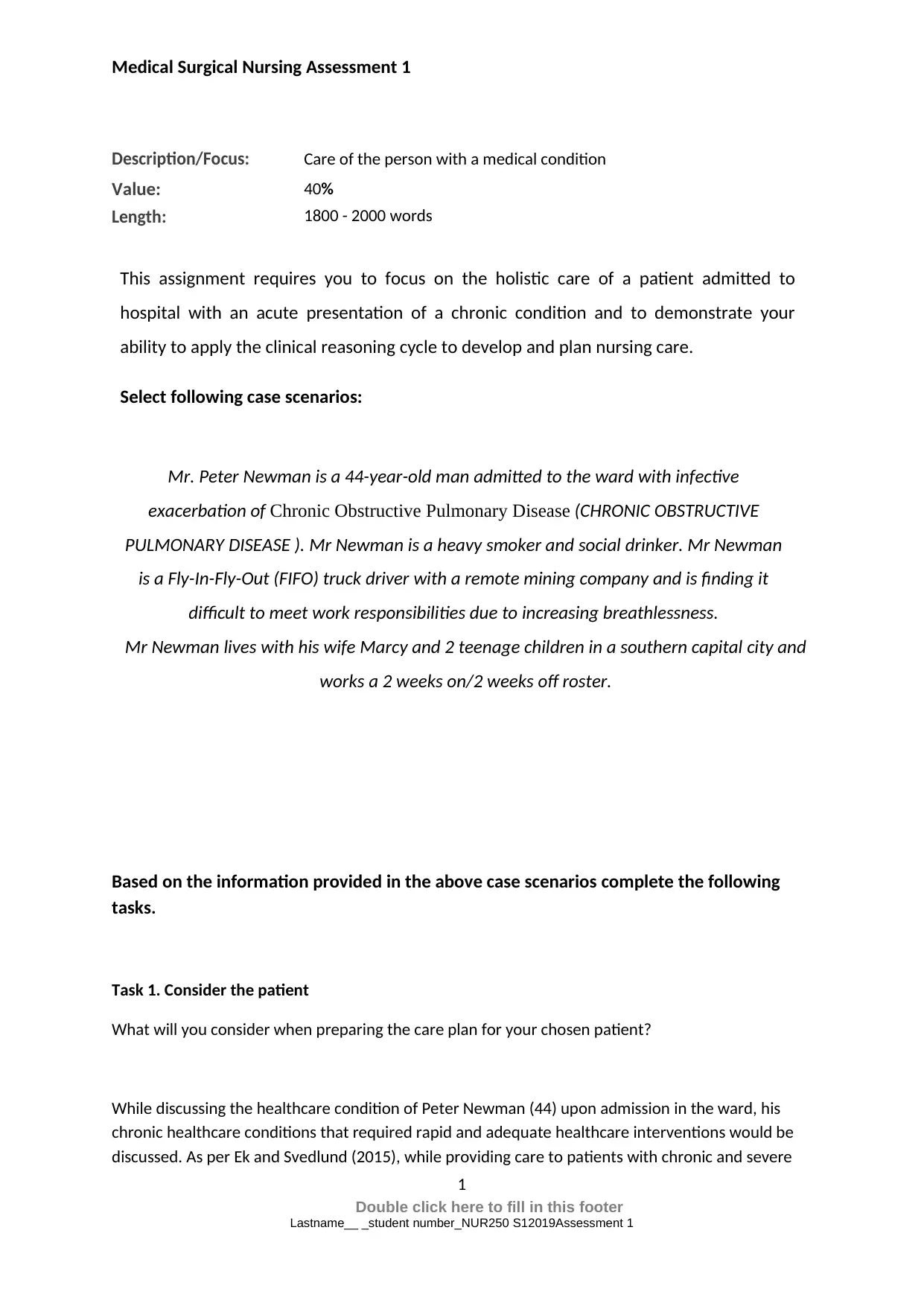
Medical Surgical Nursing Assessment 1
Description/Focus: Care of the person with a medical condition
Value: 40%
Length: 1800 - 2000 words
This assignment requires you to focus on the holistic care of a patient admitted to
hospital with an acute presentation of a chronic condition and to demonstrate your
ability to apply the clinical reasoning cycle to develop and plan nursing care.
Select following case scenarios:
Mr. Peter Newman is a 44-year-old man admitted to the ward with infective
exacerbation of Chronic Obstructive Pulmonary Disease (CHRONIC OBSTRUCTIVE
PULMONARY DISEASE ). Mr Newman is a heavy smoker and social drinker. Mr Newman
is a Fly-In-Fly-Out (FIFO) truck driver with a remote mining company and is finding it
difficult to meet work responsibilities due to increasing breathlessness.
Mr Newman lives with his wife Marcy and 2 teenage children in a southern capital city and
works a 2 weeks on/2 weeks off roster.
Based on the information provided in the above case scenarios complete the following
tasks.
Task 1. Consider the patient
What will you consider when preparing the care plan for your chosen patient?
While discussing the healthcare condition of Peter Newman (44) upon admission in the ward, his
chronic healthcare conditions that required rapid and adequate healthcare interventions would be
discussed. As per Ek and Svedlund (2015), while providing care to patients with chronic and severe
1
Double click here to fill in this footer
Lastname__ _student number_NUR250 S12019Assessment 1
Description/Focus: Care of the person with a medical condition
Value: 40%
Length: 1800 - 2000 words
This assignment requires you to focus on the holistic care of a patient admitted to
hospital with an acute presentation of a chronic condition and to demonstrate your
ability to apply the clinical reasoning cycle to develop and plan nursing care.
Select following case scenarios:
Mr. Peter Newman is a 44-year-old man admitted to the ward with infective
exacerbation of Chronic Obstructive Pulmonary Disease (CHRONIC OBSTRUCTIVE
PULMONARY DISEASE ). Mr Newman is a heavy smoker and social drinker. Mr Newman
is a Fly-In-Fly-Out (FIFO) truck driver with a remote mining company and is finding it
difficult to meet work responsibilities due to increasing breathlessness.
Mr Newman lives with his wife Marcy and 2 teenage children in a southern capital city and
works a 2 weeks on/2 weeks off roster.
Based on the information provided in the above case scenarios complete the following
tasks.
Task 1. Consider the patient
What will you consider when preparing the care plan for your chosen patient?
While discussing the healthcare condition of Peter Newman (44) upon admission in the ward, his
chronic healthcare conditions that required rapid and adequate healthcare interventions would be
discussed. As per Ek and Svedlund (2015), while providing care to patients with chronic and severe
1
Double click here to fill in this footer
Lastname__ _student number_NUR250 S12019Assessment 1
Secure Best Marks with AI Grader
Need help grading? Try our AI Grader for instant feedback on your assignments.
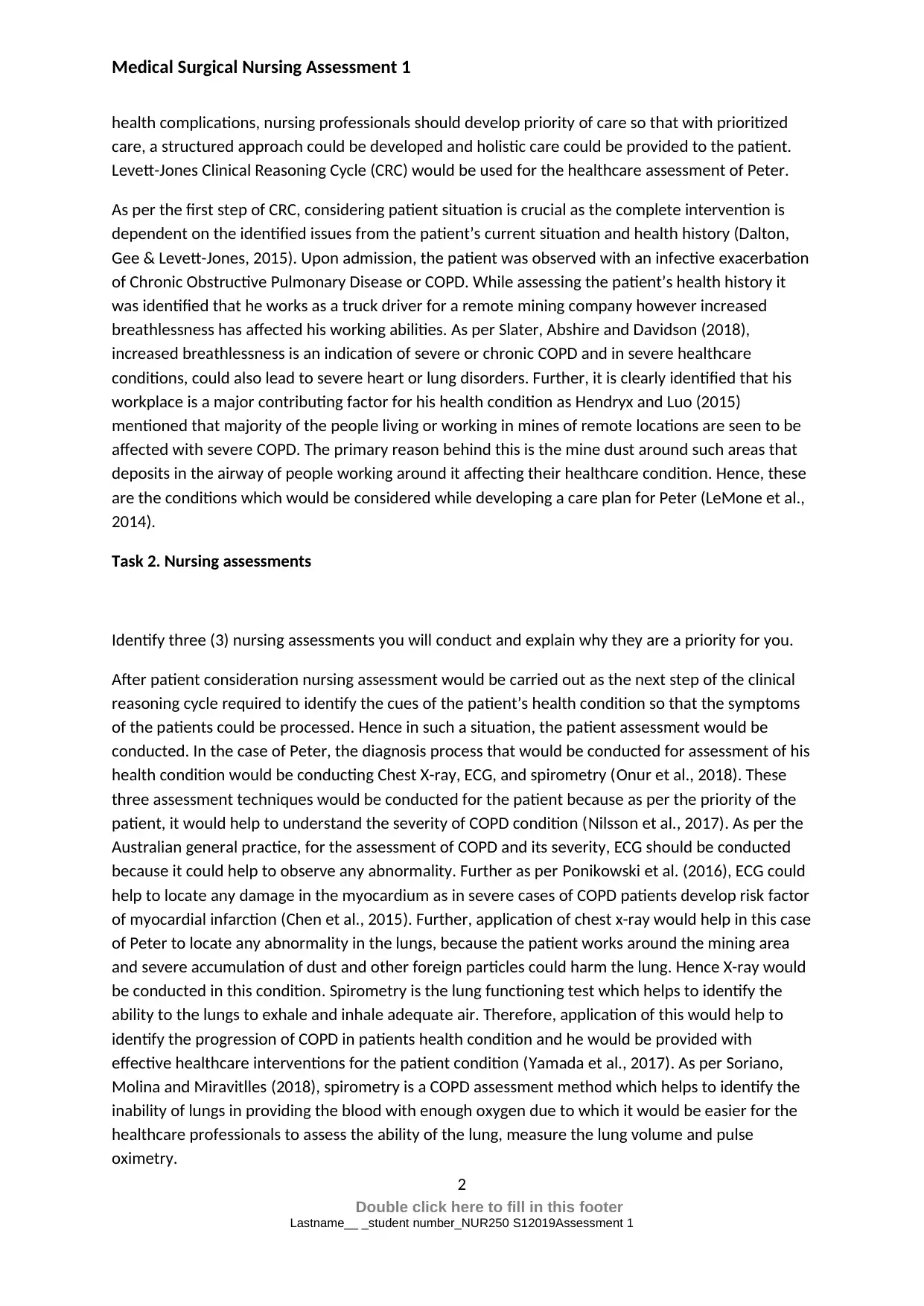
Medical Surgical Nursing Assessment 1
health complications, nursing professionals should develop priority of care so that with prioritized
care, a structured approach could be developed and holistic care could be provided to the patient.
Levett-Jones Clinical Reasoning Cycle (CRC) would be used for the healthcare assessment of Peter.
As per the first step of CRC, considering patient situation is crucial as the complete intervention is
dependent on the identified issues from the patient’s current situation and health history (Dalton,
Gee & Levett-Jones, 2015). Upon admission, the patient was observed with an infective exacerbation
of Chronic Obstructive Pulmonary Disease or COPD. While assessing the patient’s health history it
was identified that he works as a truck driver for a remote mining company however increased
breathlessness has affected his working abilities. As per Slater, Abshire and Davidson (2018),
increased breathlessness is an indication of severe or chronic COPD and in severe healthcare
conditions, could also lead to severe heart or lung disorders. Further, it is clearly identified that his
workplace is a major contributing factor for his health condition as Hendryx and Luo (2015)
mentioned that majority of the people living or working in mines of remote locations are seen to be
affected with severe COPD. The primary reason behind this is the mine dust around such areas that
deposits in the airway of people working around it affecting their healthcare condition. Hence, these
are the conditions which would be considered while developing a care plan for Peter (LeMone et al.,
2014).
Task 2. Nursing assessments
Identify three (3) nursing assessments you will conduct and explain why they are a priority for you.
After patient consideration nursing assessment would be carried out as the next step of the clinical
reasoning cycle required to identify the cues of the patient’s health condition so that the symptoms
of the patients could be processed. Hence in such a situation, the patient assessment would be
conducted. In the case of Peter, the diagnosis process that would be conducted for assessment of his
health condition would be conducting Chest X-ray, ECG, and spirometry (Onur et al., 2018). These
three assessment techniques would be conducted for the patient because as per the priority of the
patient, it would help to understand the severity of COPD condition (Nilsson et al., 2017). As per the
Australian general practice, for the assessment of COPD and its severity, ECG should be conducted
because it could help to observe any abnormality. Further as per Ponikowski et al. (2016), ECG could
help to locate any damage in the myocardium as in severe cases of COPD patients develop risk factor
of myocardial infarction (Chen et al., 2015). Further, application of chest x-ray would help in this case
of Peter to locate any abnormality in the lungs, because the patient works around the mining area
and severe accumulation of dust and other foreign particles could harm the lung. Hence X-ray would
be conducted in this condition. Spirometry is the lung functioning test which helps to identify the
ability to the lungs to exhale and inhale adequate air. Therefore, application of this would help to
identify the progression of COPD in patients health condition and he would be provided with
effective healthcare interventions for the patient condition (Yamada et al., 2017). As per Soriano,
Molina and Miravitlles (2018), spirometry is a COPD assessment method which helps to identify the
inability of lungs in providing the blood with enough oxygen due to which it would be easier for the
healthcare professionals to assess the ability of the lung, measure the lung volume and pulse
oximetry.
2
Double click here to fill in this footer
Lastname__ _student number_NUR250 S12019Assessment 1
health complications, nursing professionals should develop priority of care so that with prioritized
care, a structured approach could be developed and holistic care could be provided to the patient.
Levett-Jones Clinical Reasoning Cycle (CRC) would be used for the healthcare assessment of Peter.
As per the first step of CRC, considering patient situation is crucial as the complete intervention is
dependent on the identified issues from the patient’s current situation and health history (Dalton,
Gee & Levett-Jones, 2015). Upon admission, the patient was observed with an infective exacerbation
of Chronic Obstructive Pulmonary Disease or COPD. While assessing the patient’s health history it
was identified that he works as a truck driver for a remote mining company however increased
breathlessness has affected his working abilities. As per Slater, Abshire and Davidson (2018),
increased breathlessness is an indication of severe or chronic COPD and in severe healthcare
conditions, could also lead to severe heart or lung disorders. Further, it is clearly identified that his
workplace is a major contributing factor for his health condition as Hendryx and Luo (2015)
mentioned that majority of the people living or working in mines of remote locations are seen to be
affected with severe COPD. The primary reason behind this is the mine dust around such areas that
deposits in the airway of people working around it affecting their healthcare condition. Hence, these
are the conditions which would be considered while developing a care plan for Peter (LeMone et al.,
2014).
Task 2. Nursing assessments
Identify three (3) nursing assessments you will conduct and explain why they are a priority for you.
After patient consideration nursing assessment would be carried out as the next step of the clinical
reasoning cycle required to identify the cues of the patient’s health condition so that the symptoms
of the patients could be processed. Hence in such a situation, the patient assessment would be
conducted. In the case of Peter, the diagnosis process that would be conducted for assessment of his
health condition would be conducting Chest X-ray, ECG, and spirometry (Onur et al., 2018). These
three assessment techniques would be conducted for the patient because as per the priority of the
patient, it would help to understand the severity of COPD condition (Nilsson et al., 2017). As per the
Australian general practice, for the assessment of COPD and its severity, ECG should be conducted
because it could help to observe any abnormality. Further as per Ponikowski et al. (2016), ECG could
help to locate any damage in the myocardium as in severe cases of COPD patients develop risk factor
of myocardial infarction (Chen et al., 2015). Further, application of chest x-ray would help in this case
of Peter to locate any abnormality in the lungs, because the patient works around the mining area
and severe accumulation of dust and other foreign particles could harm the lung. Hence X-ray would
be conducted in this condition. Spirometry is the lung functioning test which helps to identify the
ability to the lungs to exhale and inhale adequate air. Therefore, application of this would help to
identify the progression of COPD in patients health condition and he would be provided with
effective healthcare interventions for the patient condition (Yamada et al., 2017). As per Soriano,
Molina and Miravitlles (2018), spirometry is a COPD assessment method which helps to identify the
inability of lungs in providing the blood with enough oxygen due to which it would be easier for the
healthcare professionals to assess the ability of the lung, measure the lung volume and pulse
oximetry.
2
Double click here to fill in this footer
Lastname__ _student number_NUR250 S12019Assessment 1
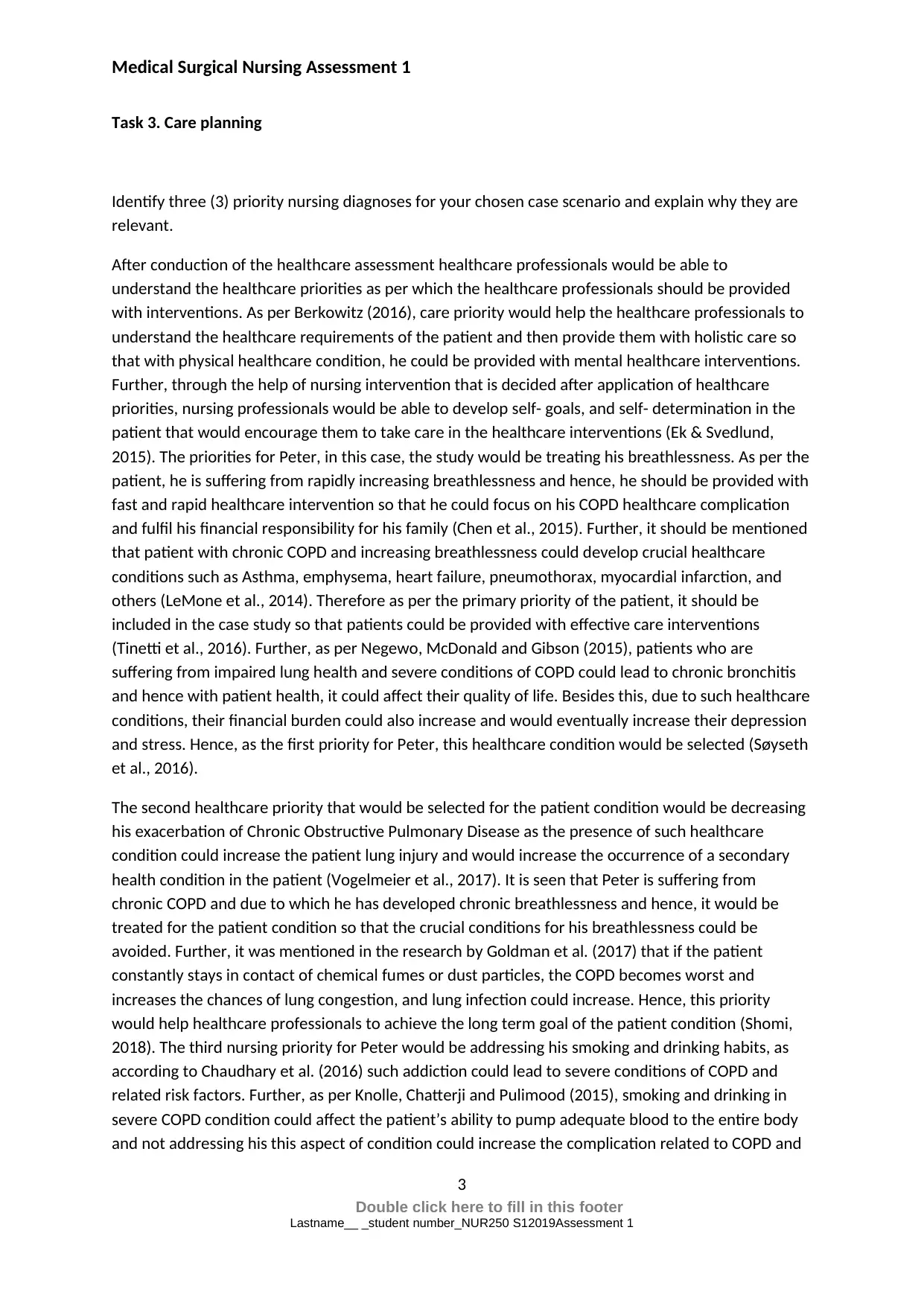
Medical Surgical Nursing Assessment 1
Task 3. Care planning
Identify three (3) priority nursing diagnoses for your chosen case scenario and explain why they are
relevant.
After conduction of the healthcare assessment healthcare professionals would be able to
understand the healthcare priorities as per which the healthcare professionals should be provided
with interventions. As per Berkowitz (2016), care priority would help the healthcare professionals to
understand the healthcare requirements of the patient and then provide them with holistic care so
that with physical healthcare condition, he could be provided with mental healthcare interventions.
Further, through the help of nursing intervention that is decided after application of healthcare
priorities, nursing professionals would be able to develop self- goals, and self- determination in the
patient that would encourage them to take care in the healthcare interventions (Ek & Svedlund,
2015). The priorities for Peter, in this case, the study would be treating his breathlessness. As per the
patient, he is suffering from rapidly increasing breathlessness and hence, he should be provided with
fast and rapid healthcare intervention so that he could focus on his COPD healthcare complication
and fulfil his financial responsibility for his family (Chen et al., 2015). Further, it should be mentioned
that patient with chronic COPD and increasing breathlessness could develop crucial healthcare
conditions such as Asthma, emphysema, heart failure, pneumothorax, myocardial infarction, and
others (LeMone et al., 2014). Therefore as per the primary priority of the patient, it should be
included in the case study so that patients could be provided with effective care interventions
(Tinetti et al., 2016). Further, as per Negewo, McDonald and Gibson (2015), patients who are
suffering from impaired lung health and severe conditions of COPD could lead to chronic bronchitis
and hence with patient health, it could affect their quality of life. Besides this, due to such healthcare
conditions, their financial burden could also increase and would eventually increase their depression
and stress. Hence, as the first priority for Peter, this healthcare condition would be selected (Søyseth
et al., 2016).
The second healthcare priority that would be selected for the patient condition would be decreasing
his exacerbation of Chronic Obstructive Pulmonary Disease as the presence of such healthcare
condition could increase the patient lung injury and would increase the occurrence of a secondary
health condition in the patient (Vogelmeier et al., 2017). It is seen that Peter is suffering from
chronic COPD and due to which he has developed chronic breathlessness and hence, it would be
treated for the patient condition so that the crucial conditions for his breathlessness could be
avoided. Further, it was mentioned in the research by Goldman et al. (2017) that if the patient
constantly stays in contact of chemical fumes or dust particles, the COPD becomes worst and
increases the chances of lung congestion, and lung infection could increase. Hence, this priority
would help healthcare professionals to achieve the long term goal of the patient condition (Shomi,
2018). The third nursing priority for Peter would be addressing his smoking and drinking habits, as
according to Chaudhary et al. (2016) such addiction could lead to severe conditions of COPD and
related risk factors. Further, as per Knolle, Chatterji and Pulimood (2015), smoking and drinking in
severe COPD condition could affect the patient’s ability to pump adequate blood to the entire body
and not addressing his this aspect of condition could increase the complication related to COPD and
3
Double click here to fill in this footer
Lastname__ _student number_NUR250 S12019Assessment 1
Task 3. Care planning
Identify three (3) priority nursing diagnoses for your chosen case scenario and explain why they are
relevant.
After conduction of the healthcare assessment healthcare professionals would be able to
understand the healthcare priorities as per which the healthcare professionals should be provided
with interventions. As per Berkowitz (2016), care priority would help the healthcare professionals to
understand the healthcare requirements of the patient and then provide them with holistic care so
that with physical healthcare condition, he could be provided with mental healthcare interventions.
Further, through the help of nursing intervention that is decided after application of healthcare
priorities, nursing professionals would be able to develop self- goals, and self- determination in the
patient that would encourage them to take care in the healthcare interventions (Ek & Svedlund,
2015). The priorities for Peter, in this case, the study would be treating his breathlessness. As per the
patient, he is suffering from rapidly increasing breathlessness and hence, he should be provided with
fast and rapid healthcare intervention so that he could focus on his COPD healthcare complication
and fulfil his financial responsibility for his family (Chen et al., 2015). Further, it should be mentioned
that patient with chronic COPD and increasing breathlessness could develop crucial healthcare
conditions such as Asthma, emphysema, heart failure, pneumothorax, myocardial infarction, and
others (LeMone et al., 2014). Therefore as per the primary priority of the patient, it should be
included in the case study so that patients could be provided with effective care interventions
(Tinetti et al., 2016). Further, as per Negewo, McDonald and Gibson (2015), patients who are
suffering from impaired lung health and severe conditions of COPD could lead to chronic bronchitis
and hence with patient health, it could affect their quality of life. Besides this, due to such healthcare
conditions, their financial burden could also increase and would eventually increase their depression
and stress. Hence, as the first priority for Peter, this healthcare condition would be selected (Søyseth
et al., 2016).
The second healthcare priority that would be selected for the patient condition would be decreasing
his exacerbation of Chronic Obstructive Pulmonary Disease as the presence of such healthcare
condition could increase the patient lung injury and would increase the occurrence of a secondary
health condition in the patient (Vogelmeier et al., 2017). It is seen that Peter is suffering from
chronic COPD and due to which he has developed chronic breathlessness and hence, it would be
treated for the patient condition so that the crucial conditions for his breathlessness could be
avoided. Further, it was mentioned in the research by Goldman et al. (2017) that if the patient
constantly stays in contact of chemical fumes or dust particles, the COPD becomes worst and
increases the chances of lung congestion, and lung infection could increase. Hence, this priority
would help healthcare professionals to achieve the long term goal of the patient condition (Shomi,
2018). The third nursing priority for Peter would be addressing his smoking and drinking habits, as
according to Chaudhary et al. (2016) such addiction could lead to severe conditions of COPD and
related risk factors. Further, as per Knolle, Chatterji and Pulimood (2015), smoking and drinking in
severe COPD condition could affect the patient’s ability to pump adequate blood to the entire body
and not addressing his this aspect of condition could increase the complication related to COPD and
3
Double click here to fill in this footer
Lastname__ _student number_NUR250 S12019Assessment 1
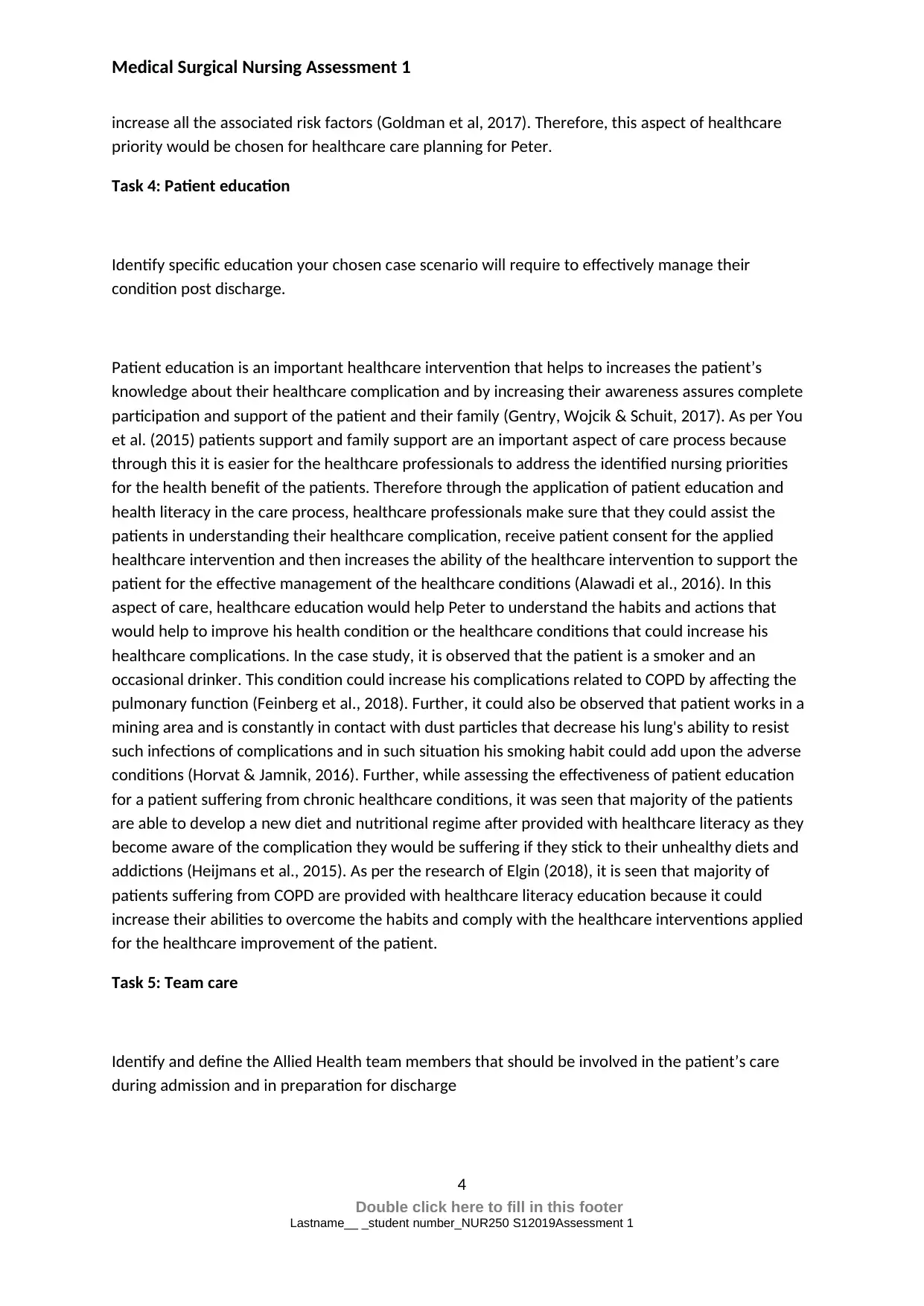
Medical Surgical Nursing Assessment 1
increase all the associated risk factors (Goldman et al, 2017). Therefore, this aspect of healthcare
priority would be chosen for healthcare care planning for Peter.
Task 4: Patient education
Identify specific education your chosen case scenario will require to effectively manage their
condition post discharge.
Patient education is an important healthcare intervention that helps to increases the patient’s
knowledge about their healthcare complication and by increasing their awareness assures complete
participation and support of the patient and their family (Gentry, Wojcik & Schuit, 2017). As per You
et al. (2015) patients support and family support are an important aspect of care process because
through this it is easier for the healthcare professionals to address the identified nursing priorities
for the health benefit of the patients. Therefore through the application of patient education and
health literacy in the care process, healthcare professionals make sure that they could assist the
patients in understanding their healthcare complication, receive patient consent for the applied
healthcare intervention and then increases the ability of the healthcare intervention to support the
patient for the effective management of the healthcare conditions (Alawadi et al., 2016). In this
aspect of care, healthcare education would help Peter to understand the habits and actions that
would help to improve his health condition or the healthcare conditions that could increase his
healthcare complications. In the case study, it is observed that the patient is a smoker and an
occasional drinker. This condition could increase his complications related to COPD by affecting the
pulmonary function (Feinberg et al., 2018). Further, it could also be observed that patient works in a
mining area and is constantly in contact with dust particles that decrease his lung's ability to resist
such infections of complications and in such situation his smoking habit could add upon the adverse
conditions (Horvat & Jamnik, 2016). Further, while assessing the effectiveness of patient education
for a patient suffering from chronic healthcare conditions, it was seen that majority of the patients
are able to develop a new diet and nutritional regime after provided with healthcare literacy as they
become aware of the complication they would be suffering if they stick to their unhealthy diets and
addictions (Heijmans et al., 2015). As per the research of Elgin (2018), it is seen that majority of
patients suffering from COPD are provided with healthcare literacy education because it could
increase their abilities to overcome the habits and comply with the healthcare interventions applied
for the healthcare improvement of the patient.
Task 5: Team care
Identify and define the Allied Health team members that should be involved in the patient’s care
during admission and in preparation for discharge
4
Double click here to fill in this footer
Lastname__ _student number_NUR250 S12019Assessment 1
increase all the associated risk factors (Goldman et al, 2017). Therefore, this aspect of healthcare
priority would be chosen for healthcare care planning for Peter.
Task 4: Patient education
Identify specific education your chosen case scenario will require to effectively manage their
condition post discharge.
Patient education is an important healthcare intervention that helps to increases the patient’s
knowledge about their healthcare complication and by increasing their awareness assures complete
participation and support of the patient and their family (Gentry, Wojcik & Schuit, 2017). As per You
et al. (2015) patients support and family support are an important aspect of care process because
through this it is easier for the healthcare professionals to address the identified nursing priorities
for the health benefit of the patients. Therefore through the application of patient education and
health literacy in the care process, healthcare professionals make sure that they could assist the
patients in understanding their healthcare complication, receive patient consent for the applied
healthcare intervention and then increases the ability of the healthcare intervention to support the
patient for the effective management of the healthcare conditions (Alawadi et al., 2016). In this
aspect of care, healthcare education would help Peter to understand the habits and actions that
would help to improve his health condition or the healthcare conditions that could increase his
healthcare complications. In the case study, it is observed that the patient is a smoker and an
occasional drinker. This condition could increase his complications related to COPD by affecting the
pulmonary function (Feinberg et al., 2018). Further, it could also be observed that patient works in a
mining area and is constantly in contact with dust particles that decrease his lung's ability to resist
such infections of complications and in such situation his smoking habit could add upon the adverse
conditions (Horvat & Jamnik, 2016). Further, while assessing the effectiveness of patient education
for a patient suffering from chronic healthcare conditions, it was seen that majority of the patients
are able to develop a new diet and nutritional regime after provided with healthcare literacy as they
become aware of the complication they would be suffering if they stick to their unhealthy diets and
addictions (Heijmans et al., 2015). As per the research of Elgin (2018), it is seen that majority of
patients suffering from COPD are provided with healthcare literacy education because it could
increase their abilities to overcome the habits and comply with the healthcare interventions applied
for the healthcare improvement of the patient.
Task 5: Team care
Identify and define the Allied Health team members that should be involved in the patient’s care
during admission and in preparation for discharge
4
Double click here to fill in this footer
Lastname__ _student number_NUR250 S12019Assessment 1
Secure Best Marks with AI Grader
Need help grading? Try our AI Grader for instant feedback on your assignments.

Medical Surgical Nursing Assessment 1
Team care in healthcare facilities is termed as a team of healthcare professionals with different
abilities and specialization so that while application of healthcare application, the interventions
could be holistic and interventions could be applied by all the specialized care professionals
(Gillespie et al., 2015). Such a team with multiple abilities and multiple professionals are also known
as the multidisciplinary team with help to increase the functionality and ability of the healthcare
professionals. The function of such teams involved in the healthcare process is to provide the patient
with assistance in activities of daily life, help in the rehabilitation and preparing them for their
discharge (Kinnear et al., 2017). Such professionals could be healthcare physiotherapist,
occupational therapists, nutritionist, care professionals involved in the nursing diagnosis or care
professionals that are involving inpatient surgery (LeMone et al., 2014).
In this case study of Peter, it is seen that his COPD condition is increasing rapidly and due to this
rapid increase in the breathlessness was observed. Hence, in such condition patient should be
provided with physical workout and aerobic activities. As per Alahmari et al. (2016), in patients with
COPD physical exercise helps to increase the rapid blood circulation in the bodily organs and helps to
maintain the blood pressure. Further, through physical exercise patients with COPD developed
energy as their shortness of breath associated conditions are treated (Liu et al., 2016). Besides this,
the application of aerobic exercise helps to lung to collect more oxygen and provide it to the organs
through blood and hence, blood pressure, abilities of the cardiac muscles and other increases
(Alahmari et al., 2016). Therefore as per Robles et al. (2017), aerobic healthcare exercises and
physical exercise in the COPD condition of John would be included so that all the critical healthcare
complications could be removed. The second team member that would be included in the care
process of Peter would be the nursing educator so that she could provide the patient with all the
necessary healthcare information and patient education which is required for the healthcare benefit
of the patient. As per Kinnear et al. (2017), providing the patient with healthcare education would
help them to understand the complication of their health condition and through the provided
intervention they would provide their complete support to the healthcare professionals so that
effective care could be achieved through the healthcare interventions. Further to achieve complete
and overall health of the patient, he would be provided with a training using which he could protect
himself while working in such mining area that increases his risk factors of COPD and severe
breathlessness (Alahmari et al., 2016). Hence, this would also be targeted in the educational
planning and healthcare professionals would be included for the patient education in this process.
5
Double click here to fill in this footer
Lastname__ _student number_NUR250 S12019Assessment 1
Team care in healthcare facilities is termed as a team of healthcare professionals with different
abilities and specialization so that while application of healthcare application, the interventions
could be holistic and interventions could be applied by all the specialized care professionals
(Gillespie et al., 2015). Such a team with multiple abilities and multiple professionals are also known
as the multidisciplinary team with help to increase the functionality and ability of the healthcare
professionals. The function of such teams involved in the healthcare process is to provide the patient
with assistance in activities of daily life, help in the rehabilitation and preparing them for their
discharge (Kinnear et al., 2017). Such professionals could be healthcare physiotherapist,
occupational therapists, nutritionist, care professionals involved in the nursing diagnosis or care
professionals that are involving inpatient surgery (LeMone et al., 2014).
In this case study of Peter, it is seen that his COPD condition is increasing rapidly and due to this
rapid increase in the breathlessness was observed. Hence, in such condition patient should be
provided with physical workout and aerobic activities. As per Alahmari et al. (2016), in patients with
COPD physical exercise helps to increase the rapid blood circulation in the bodily organs and helps to
maintain the blood pressure. Further, through physical exercise patients with COPD developed
energy as their shortness of breath associated conditions are treated (Liu et al., 2016). Besides this,
the application of aerobic exercise helps to lung to collect more oxygen and provide it to the organs
through blood and hence, blood pressure, abilities of the cardiac muscles and other increases
(Alahmari et al., 2016). Therefore as per Robles et al. (2017), aerobic healthcare exercises and
physical exercise in the COPD condition of John would be included so that all the critical healthcare
complications could be removed. The second team member that would be included in the care
process of Peter would be the nursing educator so that she could provide the patient with all the
necessary healthcare information and patient education which is required for the healthcare benefit
of the patient. As per Kinnear et al. (2017), providing the patient with healthcare education would
help them to understand the complication of their health condition and through the provided
intervention they would provide their complete support to the healthcare professionals so that
effective care could be achieved through the healthcare interventions. Further to achieve complete
and overall health of the patient, he would be provided with a training using which he could protect
himself while working in such mining area that increases his risk factors of COPD and severe
breathlessness (Alahmari et al., 2016). Hence, this would also be targeted in the educational
planning and healthcare professionals would be included for the patient education in this process.
5
Double click here to fill in this footer
Lastname__ _student number_NUR250 S12019Assessment 1
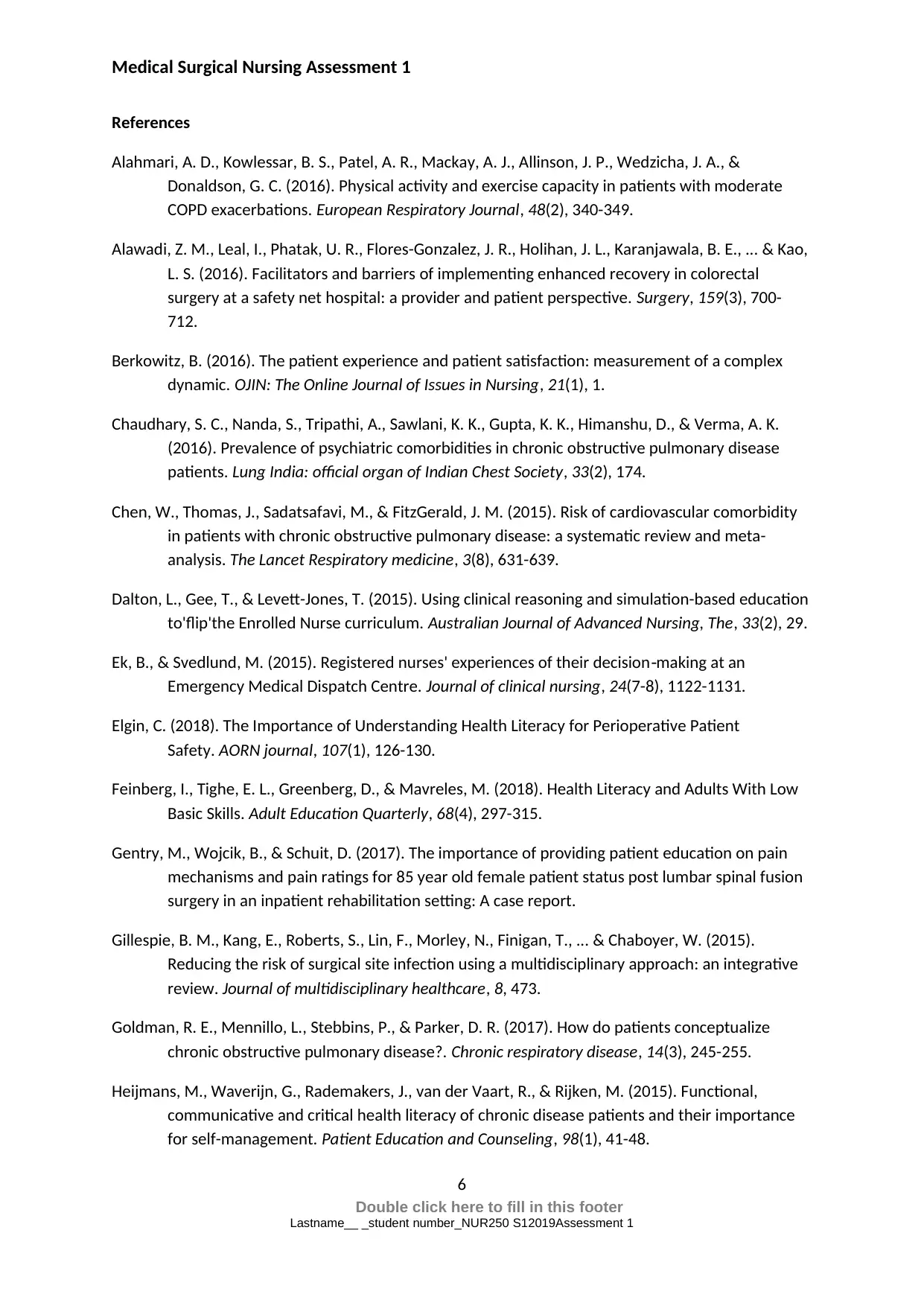
Medical Surgical Nursing Assessment 1
References
Alahmari, A. D., Kowlessar, B. S., Patel, A. R., Mackay, A. J., Allinson, J. P., Wedzicha, J. A., &
Donaldson, G. C. (2016). Physical activity and exercise capacity in patients with moderate
COPD exacerbations. European Respiratory Journal, 48(2), 340-349.
Alawadi, Z. M., Leal, I., Phatak, U. R., Flores-Gonzalez, J. R., Holihan, J. L., Karanjawala, B. E., ... & Kao,
L. S. (2016). Facilitators and barriers of implementing enhanced recovery in colorectal
surgery at a safety net hospital: a provider and patient perspective. Surgery, 159(3), 700-
712.
Berkowitz, B. (2016). The patient experience and patient satisfaction: measurement of a complex
dynamic. OJIN: The Online Journal of Issues in Nursing, 21(1), 1.
Chaudhary, S. C., Nanda, S., Tripathi, A., Sawlani, K. K., Gupta, K. K., Himanshu, D., & Verma, A. K.
(2016). Prevalence of psychiatric comorbidities in chronic obstructive pulmonary disease
patients. Lung India: official organ of Indian Chest Society, 33(2), 174.
Chen, W., Thomas, J., Sadatsafavi, M., & FitzGerald, J. M. (2015). Risk of cardiovascular comorbidity
in patients with chronic obstructive pulmonary disease: a systematic review and meta-
analysis. The Lancet Respiratory medicine, 3(8), 631-639.
Dalton, L., Gee, T., & Levett-Jones, T. (2015). Using clinical reasoning and simulation-based education
to'flip'the Enrolled Nurse curriculum. Australian Journal of Advanced Nursing, The, 33(2), 29.
Ek, B., & Svedlund, M. (2015). Registered nurses' experiences of their decision making at an‐
Emergency Medical Dispatch Centre. Journal of clinical nursing, 24(7-8), 1122-1131.
Elgin, C. (2018). The Importance of Understanding Health Literacy for Perioperative Patient
Safety. AORN journal, 107(1), 126-130.
Feinberg, I., Tighe, E. L., Greenberg, D., & Mavreles, M. (2018). Health Literacy and Adults With Low
Basic Skills. Adult Education Quarterly, 68(4), 297-315.
Gentry, M., Wojcik, B., & Schuit, D. (2017). The importance of providing patient education on pain
mechanisms and pain ratings for 85 year old female patient status post lumbar spinal fusion
surgery in an inpatient rehabilitation setting: A case report.
Gillespie, B. M., Kang, E., Roberts, S., Lin, F., Morley, N., Finigan, T., ... & Chaboyer, W. (2015).
Reducing the risk of surgical site infection using a multidisciplinary approach: an integrative
review. Journal of multidisciplinary healthcare, 8, 473.
Goldman, R. E., Mennillo, L., Stebbins, P., & Parker, D. R. (2017). How do patients conceptualize
chronic obstructive pulmonary disease?. Chronic respiratory disease, 14(3), 245-255.
Heijmans, M., Waverijn, G., Rademakers, J., van der Vaart, R., & Rijken, M. (2015). Functional,
communicative and critical health literacy of chronic disease patients and their importance
for self-management. Patient Education and Counseling, 98(1), 41-48.
6
Double click here to fill in this footer
Lastname__ _student number_NUR250 S12019Assessment 1
References
Alahmari, A. D., Kowlessar, B. S., Patel, A. R., Mackay, A. J., Allinson, J. P., Wedzicha, J. A., &
Donaldson, G. C. (2016). Physical activity and exercise capacity in patients with moderate
COPD exacerbations. European Respiratory Journal, 48(2), 340-349.
Alawadi, Z. M., Leal, I., Phatak, U. R., Flores-Gonzalez, J. R., Holihan, J. L., Karanjawala, B. E., ... & Kao,
L. S. (2016). Facilitators and barriers of implementing enhanced recovery in colorectal
surgery at a safety net hospital: a provider and patient perspective. Surgery, 159(3), 700-
712.
Berkowitz, B. (2016). The patient experience and patient satisfaction: measurement of a complex
dynamic. OJIN: The Online Journal of Issues in Nursing, 21(1), 1.
Chaudhary, S. C., Nanda, S., Tripathi, A., Sawlani, K. K., Gupta, K. K., Himanshu, D., & Verma, A. K.
(2016). Prevalence of psychiatric comorbidities in chronic obstructive pulmonary disease
patients. Lung India: official organ of Indian Chest Society, 33(2), 174.
Chen, W., Thomas, J., Sadatsafavi, M., & FitzGerald, J. M. (2015). Risk of cardiovascular comorbidity
in patients with chronic obstructive pulmonary disease: a systematic review and meta-
analysis. The Lancet Respiratory medicine, 3(8), 631-639.
Dalton, L., Gee, T., & Levett-Jones, T. (2015). Using clinical reasoning and simulation-based education
to'flip'the Enrolled Nurse curriculum. Australian Journal of Advanced Nursing, The, 33(2), 29.
Ek, B., & Svedlund, M. (2015). Registered nurses' experiences of their decision making at an‐
Emergency Medical Dispatch Centre. Journal of clinical nursing, 24(7-8), 1122-1131.
Elgin, C. (2018). The Importance of Understanding Health Literacy for Perioperative Patient
Safety. AORN journal, 107(1), 126-130.
Feinberg, I., Tighe, E. L., Greenberg, D., & Mavreles, M. (2018). Health Literacy and Adults With Low
Basic Skills. Adult Education Quarterly, 68(4), 297-315.
Gentry, M., Wojcik, B., & Schuit, D. (2017). The importance of providing patient education on pain
mechanisms and pain ratings for 85 year old female patient status post lumbar spinal fusion
surgery in an inpatient rehabilitation setting: A case report.
Gillespie, B. M., Kang, E., Roberts, S., Lin, F., Morley, N., Finigan, T., ... & Chaboyer, W. (2015).
Reducing the risk of surgical site infection using a multidisciplinary approach: an integrative
review. Journal of multidisciplinary healthcare, 8, 473.
Goldman, R. E., Mennillo, L., Stebbins, P., & Parker, D. R. (2017). How do patients conceptualize
chronic obstructive pulmonary disease?. Chronic respiratory disease, 14(3), 245-255.
Heijmans, M., Waverijn, G., Rademakers, J., van der Vaart, R., & Rijken, M. (2015). Functional,
communicative and critical health literacy of chronic disease patients and their importance
for self-management. Patient Education and Counseling, 98(1), 41-48.
6
Double click here to fill in this footer
Lastname__ _student number_NUR250 S12019Assessment 1
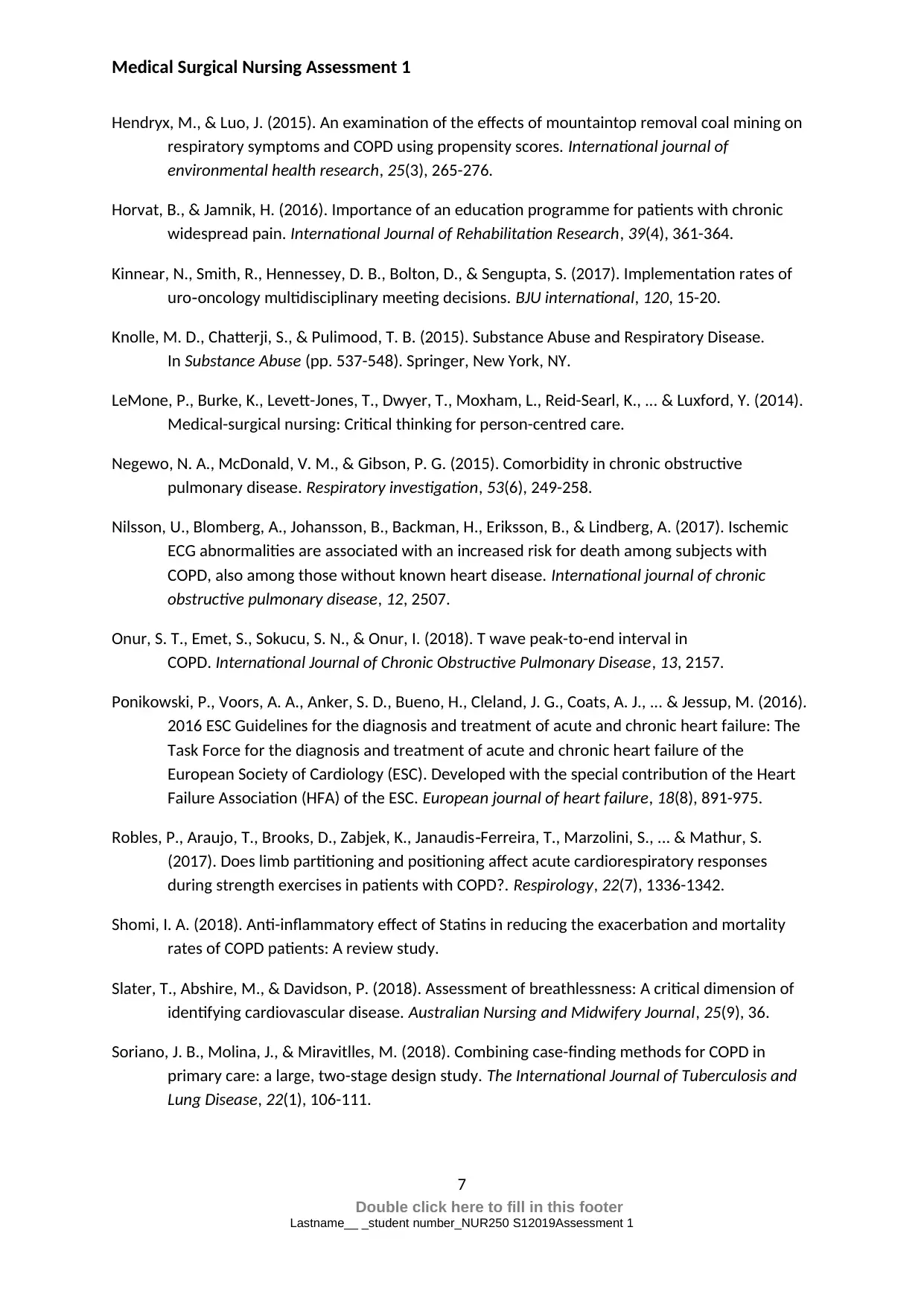
Medical Surgical Nursing Assessment 1
Hendryx, M., & Luo, J. (2015). An examination of the effects of mountaintop removal coal mining on
respiratory symptoms and COPD using propensity scores. International journal of
environmental health research, 25(3), 265-276.
Horvat, B., & Jamnik, H. (2016). Importance of an education programme for patients with chronic
widespread pain. International Journal of Rehabilitation Research, 39(4), 361-364.
Kinnear, N., Smith, R., Hennessey, D. B., Bolton, D., & Sengupta, S. (2017). Implementation rates of
uro oncology multidisciplinary meeting decisions.‐ BJU international, 120, 15-20.
Knolle, M. D., Chatterji, S., & Pulimood, T. B. (2015). Substance Abuse and Respiratory Disease.
In Substance Abuse (pp. 537-548). Springer, New York, NY.
LeMone, P., Burke, K., Levett-Jones, T., Dwyer, T., Moxham, L., Reid-Searl, K., ... & Luxford, Y. (2014).
Medical-surgical nursing: Critical thinking for person-centred care.
Negewo, N. A., McDonald, V. M., & Gibson, P. G. (2015). Comorbidity in chronic obstructive
pulmonary disease. Respiratory investigation, 53(6), 249-258.
Nilsson, U., Blomberg, A., Johansson, B., Backman, H., Eriksson, B., & Lindberg, A. (2017). Ischemic
ECG abnormalities are associated with an increased risk for death among subjects with
COPD, also among those without known heart disease. International journal of chronic
obstructive pulmonary disease, 12, 2507.
Onur, S. T., Emet, S., Sokucu, S. N., & Onur, I. (2018). T wave peak-to-end interval in
COPD. International Journal of Chronic Obstructive Pulmonary Disease, 13, 2157.
Ponikowski, P., Voors, A. A., Anker, S. D., Bueno, H., Cleland, J. G., Coats, A. J., ... & Jessup, M. (2016).
2016 ESC Guidelines for the diagnosis and treatment of acute and chronic heart failure: The
Task Force for the diagnosis and treatment of acute and chronic heart failure of the
European Society of Cardiology (ESC). Developed with the special contribution of the Heart
Failure Association (HFA) of the ESC. European journal of heart failure, 18(8), 891-975.
Robles, P., Araujo, T., Brooks, D., Zabjek, K., Janaudis Ferreira, T., Marzolini, S., ... & Mathur, S.‐
(2017). Does limb partitioning and positioning affect acute cardiorespiratory responses
during strength exercises in patients with COPD?. Respirology, 22(7), 1336-1342.
Shomi, I. A. (2018). Anti-inflammatory effect of Statins in reducing the exacerbation and mortality
rates of COPD patients: A review study.
Slater, T., Abshire, M., & Davidson, P. (2018). Assessment of breathlessness: A critical dimension of
identifying cardiovascular disease. Australian Nursing and Midwifery Journal, 25(9), 36.
Soriano, J. B., Molina, J., & Miravitlles, M. (2018). Combining case-finding methods for COPD in
primary care: a large, two-stage design study. The International Journal of Tuberculosis and
Lung Disease, 22(1), 106-111.
7
Double click here to fill in this footer
Lastname__ _student number_NUR250 S12019Assessment 1
Hendryx, M., & Luo, J. (2015). An examination of the effects of mountaintop removal coal mining on
respiratory symptoms and COPD using propensity scores. International journal of
environmental health research, 25(3), 265-276.
Horvat, B., & Jamnik, H. (2016). Importance of an education programme for patients with chronic
widespread pain. International Journal of Rehabilitation Research, 39(4), 361-364.
Kinnear, N., Smith, R., Hennessey, D. B., Bolton, D., & Sengupta, S. (2017). Implementation rates of
uro oncology multidisciplinary meeting decisions.‐ BJU international, 120, 15-20.
Knolle, M. D., Chatterji, S., & Pulimood, T. B. (2015). Substance Abuse and Respiratory Disease.
In Substance Abuse (pp. 537-548). Springer, New York, NY.
LeMone, P., Burke, K., Levett-Jones, T., Dwyer, T., Moxham, L., Reid-Searl, K., ... & Luxford, Y. (2014).
Medical-surgical nursing: Critical thinking for person-centred care.
Negewo, N. A., McDonald, V. M., & Gibson, P. G. (2015). Comorbidity in chronic obstructive
pulmonary disease. Respiratory investigation, 53(6), 249-258.
Nilsson, U., Blomberg, A., Johansson, B., Backman, H., Eriksson, B., & Lindberg, A. (2017). Ischemic
ECG abnormalities are associated with an increased risk for death among subjects with
COPD, also among those without known heart disease. International journal of chronic
obstructive pulmonary disease, 12, 2507.
Onur, S. T., Emet, S., Sokucu, S. N., & Onur, I. (2018). T wave peak-to-end interval in
COPD. International Journal of Chronic Obstructive Pulmonary Disease, 13, 2157.
Ponikowski, P., Voors, A. A., Anker, S. D., Bueno, H., Cleland, J. G., Coats, A. J., ... & Jessup, M. (2016).
2016 ESC Guidelines for the diagnosis and treatment of acute and chronic heart failure: The
Task Force for the diagnosis and treatment of acute and chronic heart failure of the
European Society of Cardiology (ESC). Developed with the special contribution of the Heart
Failure Association (HFA) of the ESC. European journal of heart failure, 18(8), 891-975.
Robles, P., Araujo, T., Brooks, D., Zabjek, K., Janaudis Ferreira, T., Marzolini, S., ... & Mathur, S.‐
(2017). Does limb partitioning and positioning affect acute cardiorespiratory responses
during strength exercises in patients with COPD?. Respirology, 22(7), 1336-1342.
Shomi, I. A. (2018). Anti-inflammatory effect of Statins in reducing the exacerbation and mortality
rates of COPD patients: A review study.
Slater, T., Abshire, M., & Davidson, P. (2018). Assessment of breathlessness: A critical dimension of
identifying cardiovascular disease. Australian Nursing and Midwifery Journal, 25(9), 36.
Soriano, J. B., Molina, J., & Miravitlles, M. (2018). Combining case-finding methods for COPD in
primary care: a large, two-stage design study. The International Journal of Tuberculosis and
Lung Disease, 22(1), 106-111.
7
Double click here to fill in this footer
Lastname__ _student number_NUR250 S12019Assessment 1
Paraphrase This Document
Need a fresh take? Get an instant paraphrase of this document with our AI Paraphraser
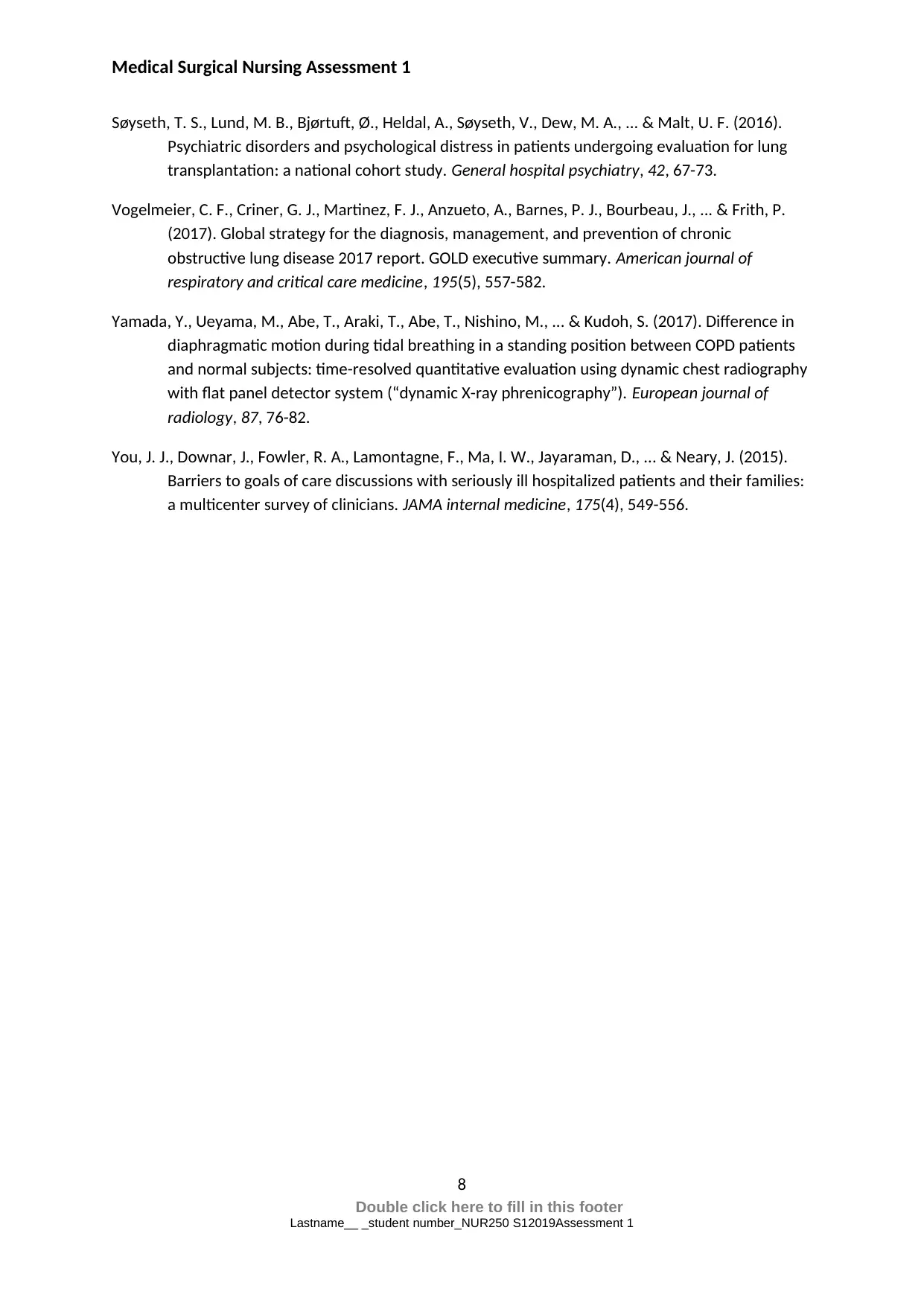
Medical Surgical Nursing Assessment 1
Søyseth, T. S., Lund, M. B., Bjørtuft, Ø., Heldal, A., Søyseth, V., Dew, M. A., ... & Malt, U. F. (2016).
Psychiatric disorders and psychological distress in patients undergoing evaluation for lung
transplantation: a national cohort study. General hospital psychiatry, 42, 67-73.
Vogelmeier, C. F., Criner, G. J., Martinez, F. J., Anzueto, A., Barnes, P. J., Bourbeau, J., ... & Frith, P.
(2017). Global strategy for the diagnosis, management, and prevention of chronic
obstructive lung disease 2017 report. GOLD executive summary. American journal of
respiratory and critical care medicine, 195(5), 557-582.
Yamada, Y., Ueyama, M., Abe, T., Araki, T., Abe, T., Nishino, M., ... & Kudoh, S. (2017). Difference in
diaphragmatic motion during tidal breathing in a standing position between COPD patients
and normal subjects: time-resolved quantitative evaluation using dynamic chest radiography
with flat panel detector system (“dynamic X-ray phrenicography”). European journal of
radiology, 87, 76-82.
You, J. J., Downar, J., Fowler, R. A., Lamontagne, F., Ma, I. W., Jayaraman, D., ... & Neary, J. (2015).
Barriers to goals of care discussions with seriously ill hospitalized patients and their families:
a multicenter survey of clinicians. JAMA internal medicine, 175(4), 549-556.
8
Double click here to fill in this footer
Lastname__ _student number_NUR250 S12019Assessment 1
Søyseth, T. S., Lund, M. B., Bjørtuft, Ø., Heldal, A., Søyseth, V., Dew, M. A., ... & Malt, U. F. (2016).
Psychiatric disorders and psychological distress in patients undergoing evaluation for lung
transplantation: a national cohort study. General hospital psychiatry, 42, 67-73.
Vogelmeier, C. F., Criner, G. J., Martinez, F. J., Anzueto, A., Barnes, P. J., Bourbeau, J., ... & Frith, P.
(2017). Global strategy for the diagnosis, management, and prevention of chronic
obstructive lung disease 2017 report. GOLD executive summary. American journal of
respiratory and critical care medicine, 195(5), 557-582.
Yamada, Y., Ueyama, M., Abe, T., Araki, T., Abe, T., Nishino, M., ... & Kudoh, S. (2017). Difference in
diaphragmatic motion during tidal breathing in a standing position between COPD patients
and normal subjects: time-resolved quantitative evaluation using dynamic chest radiography
with flat panel detector system (“dynamic X-ray phrenicography”). European journal of
radiology, 87, 76-82.
You, J. J., Downar, J., Fowler, R. A., Lamontagne, F., Ma, I. W., Jayaraman, D., ... & Neary, J. (2015).
Barriers to goals of care discussions with seriously ill hospitalized patients and their families:
a multicenter survey of clinicians. JAMA internal medicine, 175(4), 549-556.
8
Double click here to fill in this footer
Lastname__ _student number_NUR250 S12019Assessment 1
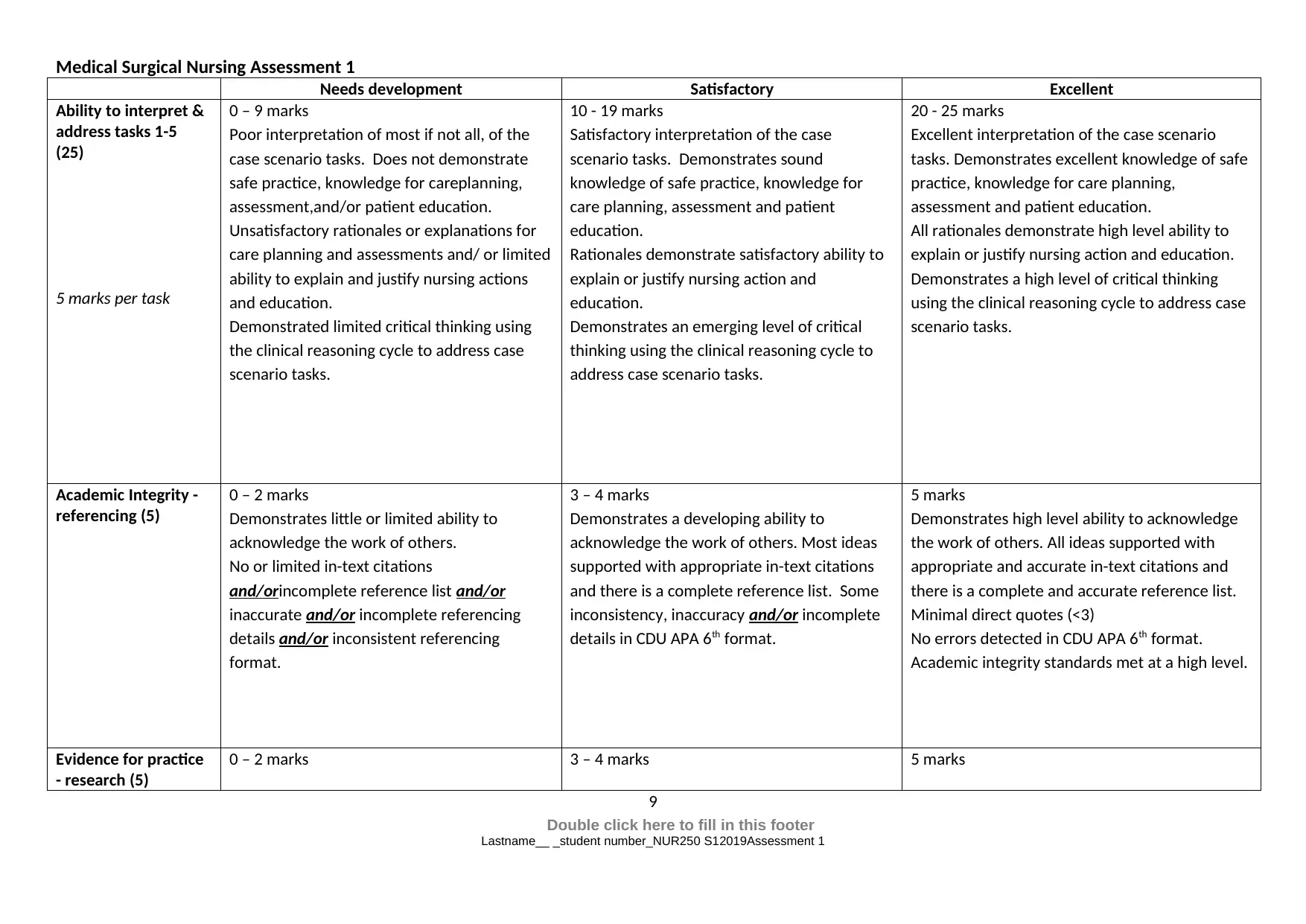
Medical Surgical Nursing Assessment 1
Needs development Satisfactory Excellent
Ability to interpret &
address tasks 1-5
(25)
5 marks per task
0 – 9 marks
Poor interpretation of most if not all, of the
case scenario tasks. Does not demonstrate
safe practice, knowledge for careplanning,
assessment,and/or patient education.
Unsatisfactory rationales or explanations for
care planning and assessments and/ or limited
ability to explain and justify nursing actions
and education.
Demonstrated limited critical thinking using
the clinical reasoning cycle to address case
scenario tasks.
10 - 19 marks
Satisfactory interpretation of the case
scenario tasks. Demonstrates sound
knowledge of safe practice, knowledge for
care planning, assessment and patient
education.
Rationales demonstrate satisfactory ability to
explain or justify nursing action and
education.
Demonstrates an emerging level of critical
thinking using the clinical reasoning cycle to
address case scenario tasks.
20 - 25 marks
Excellent interpretation of the case scenario
tasks. Demonstrates excellent knowledge of safe
practice, knowledge for care planning,
assessment and patient education.
All rationales demonstrate high level ability to
explain or justify nursing action and education.
Demonstrates a high level of critical thinking
using the clinical reasoning cycle to address case
scenario tasks.
Academic Integrity -
referencing (5)
0 – 2 marks
Demonstrates little or limited ability to
acknowledge the work of others.
No or limited in-text citations
and/orincomplete reference list and/or
inaccurate and/or incomplete referencing
details and/or inconsistent referencing
format.
3 – 4 marks
Demonstrates a developing ability to
acknowledge the work of others. Most ideas
supported with appropriate in-text citations
and there is a complete reference list. Some
inconsistency, inaccuracy and/or incomplete
details in CDU APA 6th format.
5 marks
Demonstrates high level ability to acknowledge
the work of others. All ideas supported with
appropriate and accurate in-text citations and
there is a complete and accurate reference list.
Minimal direct quotes (<3)
No errors detected in CDU APA 6th format.
Academic integrity standards met at a high level.
Evidence for practice
- research (5)
0 – 2 marks 3 – 4 marks 5 marks
9
Double click here to fill in this footer
Lastname__ _student number_NUR250 S12019Assessment 1
Needs development Satisfactory Excellent
Ability to interpret &
address tasks 1-5
(25)
5 marks per task
0 – 9 marks
Poor interpretation of most if not all, of the
case scenario tasks. Does not demonstrate
safe practice, knowledge for careplanning,
assessment,and/or patient education.
Unsatisfactory rationales or explanations for
care planning and assessments and/ or limited
ability to explain and justify nursing actions
and education.
Demonstrated limited critical thinking using
the clinical reasoning cycle to address case
scenario tasks.
10 - 19 marks
Satisfactory interpretation of the case
scenario tasks. Demonstrates sound
knowledge of safe practice, knowledge for
care planning, assessment and patient
education.
Rationales demonstrate satisfactory ability to
explain or justify nursing action and
education.
Demonstrates an emerging level of critical
thinking using the clinical reasoning cycle to
address case scenario tasks.
20 - 25 marks
Excellent interpretation of the case scenario
tasks. Demonstrates excellent knowledge of safe
practice, knowledge for care planning,
assessment and patient education.
All rationales demonstrate high level ability to
explain or justify nursing action and education.
Demonstrates a high level of critical thinking
using the clinical reasoning cycle to address case
scenario tasks.
Academic Integrity -
referencing (5)
0 – 2 marks
Demonstrates little or limited ability to
acknowledge the work of others.
No or limited in-text citations
and/orincomplete reference list and/or
inaccurate and/or incomplete referencing
details and/or inconsistent referencing
format.
3 – 4 marks
Demonstrates a developing ability to
acknowledge the work of others. Most ideas
supported with appropriate in-text citations
and there is a complete reference list. Some
inconsistency, inaccuracy and/or incomplete
details in CDU APA 6th format.
5 marks
Demonstrates high level ability to acknowledge
the work of others. All ideas supported with
appropriate and accurate in-text citations and
there is a complete and accurate reference list.
Minimal direct quotes (<3)
No errors detected in CDU APA 6th format.
Academic integrity standards met at a high level.
Evidence for practice
- research (5)
0 – 2 marks 3 – 4 marks 5 marks
9
Double click here to fill in this footer
Lastname__ _student number_NUR250 S12019Assessment 1
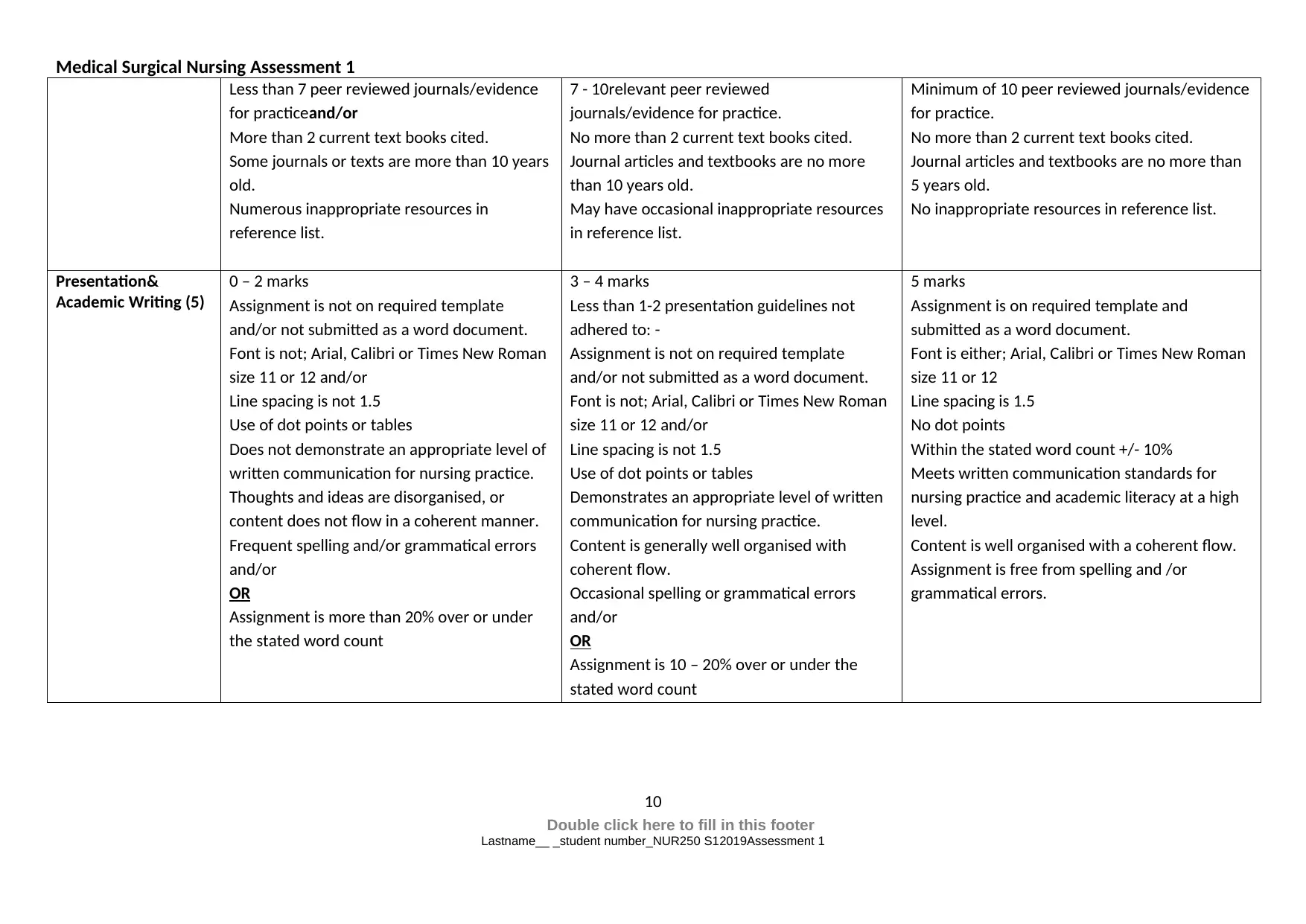
Medical Surgical Nursing Assessment 1
Less than 7 peer reviewed journals/evidence
for practiceand/or
More than 2 current text books cited.
Some journals or texts are more than 10 years
old.
Numerous inappropriate resources in
reference list.
7 - 10relevant peer reviewed
journals/evidence for practice.
No more than 2 current text books cited.
Journal articles and textbooks are no more
than 10 years old.
May have occasional inappropriate resources
in reference list.
Minimum of 10 peer reviewed journals/evidence
for practice.
No more than 2 current text books cited.
Journal articles and textbooks are no more than
5 years old.
No inappropriate resources in reference list.
Presentation&
Academic Writing (5)
0 – 2 marks
Assignment is not on required template
and/or not submitted as a word document.
Font is not; Arial, Calibri or Times New Roman
size 11 or 12 and/or
Line spacing is not 1.5
Use of dot points or tables
Does not demonstrate an appropriate level of
written communication for nursing practice.
Thoughts and ideas are disorganised, or
content does not flow in a coherent manner.
Frequent spelling and/or grammatical errors
and/or
OR
Assignment is more than 20% over or under
the stated word count
3 – 4 marks
Less than 1-2 presentation guidelines not
adhered to: -
Assignment is not on required template
and/or not submitted as a word document.
Font is not; Arial, Calibri or Times New Roman
size 11 or 12 and/or
Line spacing is not 1.5
Use of dot points or tables
Demonstrates an appropriate level of written
communication for nursing practice.
Content is generally well organised with
coherent flow.
Occasional spelling or grammatical errors
and/or
OR
Assignment is 10 – 20% over or under the
stated word count
5 marks
Assignment is on required template and
submitted as a word document.
Font is either; Arial, Calibri or Times New Roman
size 11 or 12
Line spacing is 1.5
No dot points
Within the stated word count +/- 10%
Meets written communication standards for
nursing practice and academic literacy at a high
level.
Content is well organised with a coherent flow.
Assignment is free from spelling and /or
grammatical errors.
10
Double click here to fill in this footer
Lastname__ _student number_NUR250 S12019Assessment 1
Less than 7 peer reviewed journals/evidence
for practiceand/or
More than 2 current text books cited.
Some journals or texts are more than 10 years
old.
Numerous inappropriate resources in
reference list.
7 - 10relevant peer reviewed
journals/evidence for practice.
No more than 2 current text books cited.
Journal articles and textbooks are no more
than 10 years old.
May have occasional inappropriate resources
in reference list.
Minimum of 10 peer reviewed journals/evidence
for practice.
No more than 2 current text books cited.
Journal articles and textbooks are no more than
5 years old.
No inappropriate resources in reference list.
Presentation&
Academic Writing (5)
0 – 2 marks
Assignment is not on required template
and/or not submitted as a word document.
Font is not; Arial, Calibri or Times New Roman
size 11 or 12 and/or
Line spacing is not 1.5
Use of dot points or tables
Does not demonstrate an appropriate level of
written communication for nursing practice.
Thoughts and ideas are disorganised, or
content does not flow in a coherent manner.
Frequent spelling and/or grammatical errors
and/or
OR
Assignment is more than 20% over or under
the stated word count
3 – 4 marks
Less than 1-2 presentation guidelines not
adhered to: -
Assignment is not on required template
and/or not submitted as a word document.
Font is not; Arial, Calibri or Times New Roman
size 11 or 12 and/or
Line spacing is not 1.5
Use of dot points or tables
Demonstrates an appropriate level of written
communication for nursing practice.
Content is generally well organised with
coherent flow.
Occasional spelling or grammatical errors
and/or
OR
Assignment is 10 – 20% over or under the
stated word count
5 marks
Assignment is on required template and
submitted as a word document.
Font is either; Arial, Calibri or Times New Roman
size 11 or 12
Line spacing is 1.5
No dot points
Within the stated word count +/- 10%
Meets written communication standards for
nursing practice and academic literacy at a high
level.
Content is well organised with a coherent flow.
Assignment is free from spelling and /or
grammatical errors.
10
Double click here to fill in this footer
Lastname__ _student number_NUR250 S12019Assessment 1
1 out of 10
Related Documents
Your All-in-One AI-Powered Toolkit for Academic Success.
+13062052269
info@desklib.com
Available 24*7 on WhatsApp / Email
![[object Object]](/_next/static/media/star-bottom.7253800d.svg)
Unlock your academic potential
© 2024 | Zucol Services PVT LTD | All rights reserved.





